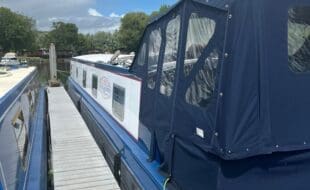A MOVE to demolish Aberdulais Aqueduct, which carries the Tennant Canal over the River Neath, has prompted an angry reaction from the Inland Waterways Association.
It has sharply criticised what it calls ‘a lazy proposal’ by Welsh Government quango Natural Resources Wales (NRW) that says it is considering demolishing the scheduled ancient monument.
Objectors only have until Monday February 26 to respond to the ‘quietly issued’ consultation at https://bit.ly/AberdulaisENG
IWA deputy chairman Sue O’Hare said: “Demolishing one of Wales’s renowned historic structures would be nothing short of bureaucratic vandalism while not achieving the aim of significantly reducing the flood risk.”
It is among five options for spending millions of pounds to reduce the flood risk for 27 properties alongside the river, which have a long history of flooding.
Two of the options, believed to be favoured by NRW, involve complete or partial demolition of the aqueduct, which would forever frustrate restoration proposals to bring the Neath and Tennant canals back to life as well as impacting the wellbeing, environmental and heritage benefits provided by the canal.
Sue commented that while IWA has every sympathy for the residents of Canal Side, A great deal of voluntary effort and public money has gone into bringing the Neath Canal back to life for the benefit of the community.
“IWA calls upon the owners of the Neath and Tennant Canals (St Modwen and Port Tennant Canal Company), Neath Port Talbot Council and the government agencies concerned to work together to rescue this precious piece of heritage and amenity for the benefit of future Welsh generations,” she added.
The Aberdulais Aqueduct spans the River Neath immediately south of the A465 in Aberdulais. The structure, approximately two miles north-east of Neath, is a 104m structure. It comprises ten arches of overall length 66me bridging the river and a retained section extending a further 28m on the east bank.
However the aqueduct is perceived as an obstruction to the flow of the river, flooding of the adjacent land and properties having occurred on several occasions. The properties in Canal Side have a long history of flooding, with damaging events in December 1979 and October 1998.
In recent years, climate change has worsened the situation and floods have become more regular, with damage to the aqueduct. A structural inspection report commissioned by IWA’s Waterway Recovery Group in December 2021 showed that urgent works were required to prevent further damage but nothing has been done so far.
In its consultation, Natural Resources Wales admits that demolition of the aqueduct would have relatively little impact in reducing floods, but the local view is that NRW would like to demolish the aqueduct so it can be seen to be doing something.
The aqueduct lies about 80m south of the confluence between the River Dulais and the River Neath close to a weir from which water is abstracted to supply the Tennant Canal. This has failed and IWA claims that Natural Resources Wales has proved uncooperative in approving its repair, leading to the Tennant Canal being nearly dry in recent years, with damage to the environment and loss of wildlife from the canal.
IWA also points out that the consultation omits any mention that the aqueduct is a Scheduled Ancient Monument or any historical background or its purpose. “Rather, it just suggests demolition as if the Aqueduct is just some pile of inconveniently discarded rubble.”
But the consultation does state that even if the aqueduct were to be demolished, that it would ‘unlikely to be able to remove the flood risk to the Aberdulais community entirely’. While alternative options, albeit more expensive, have not appeared to have been considered the consultation does state: “Additional measures (necessary) are likely to take a whole catchment approach and may include improved warning and informing, nature based solutions as well as engineered defences.”
The Aqueduct historically formed a navigable link between the Tennant and Neath Canals and was constructed to also cross over an old 1750s navigable cut on the eastern side of the river. Construction of the aqueduct began in 1823, and it was formally opened in May 1824.





